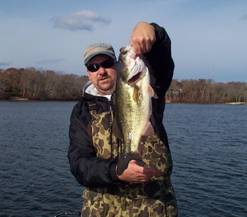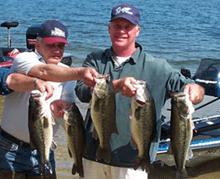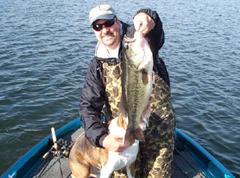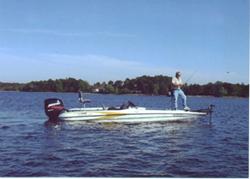|
Mike Tarmburello, Jim Halpin, and Roland Martin share their techniques to catch bass on Lake Wequaquet. These pictures are relatively old (9 years), but the fishing is still outstanding in this small lake in Barnstable. I think every bass club in Mass. and Rhode Island come here at least once during the year. The lake is always open, but the parking is not secure. You have to park on the side of the road, away from the "NO Parking" signs, and walk back to the ramp. The inconvenience is worth it!! In another page, I will talk about my techniques and try to give you an understanding about the changes in the pond in the last decade or so. Let's start with early spring time conditions. I went back to my notes from 1994-1997 and found that what was happening back then is still happening now. If the water temp. was in the 40's, the bite was tough. I couldn't really "pattern" the fish for a particular day or group of days. I would catch one here and one there, using different kinds of baits. The most common factor, was that they were coming shallow and in the cove areas, not the main lake. When the water temp. reached 50 degrees, the fish were more aggressive and the strike zone expanded. I take a lure that works well in shallow water, around 5 ft, and I target those areas of the lake where the sun will warm the water the fastest. These areas usually contain rocks, are out of the wind, and get a lot of sunshine during the day. I find that in the spring the bigger fish are more aggressive in the afternoon, so if your fishing isn't too successful in the morning, don't give up, look for those fish to be moving in the afternoon. Some of the baits I use are; sluggos, senkos, rapalas, and spinnerbaits. I like to use colors that imitate the small herring in the pond when I choose these baits. When you have to slow down and use jigs and worms; black and black and blue are my favorite. The small mouth will spawn in the main lake areas, where the small rocks and gravel is in 8 ft or less. The largemouth, will spawn in the coves around the same time, because the coves "heat" up more quickly than the main lake. Don't under estimate the intensity of the sun during a nice spring day. You may go into a cove in the morning and see absolutely nothing; and then come back in the afternoon and see and catch big largemouth which feel the need to "sit" on a bed, a stick, a stone or what have you. Post spawn is a season, not seen too much at Wequaquet, because after memorial day, you cannot use the parking lot unless you have a resident beach sticker. However, as I said above, you can launch your boat and then park up the road and walk back. Both the largemouth and small mouth are beginning to head for the main lake areas. The coves will still hold fish because the fish will move in and out. There are many "humps" in the main lake area. I have found that the fish that are on the humps will tend to bite fairly quickly. If you don't get any bites at a particular "hump", then I suggest you move to another. The "grass" in the lake has changed dramatically over the last 5 years. On one particular hump area, there was grass that would grow about 1 foot off the bottom, now the hump is covered in I believe, milfoil, which grows almost to the surface. The fish are still in the area, but I no longer fish it with a ball jig and worm, or crankbait, as they get bogged down with the grass. You must use something to penetrate the grass and fish more slowly; a weighted senko, jig, tube, etc. At the end of Labor Day weekend, the tournaments start up again, as the parking lot opens up. The fall fishing is much different now because of the over abundance of "milfoil". The techniques have changed for a lot of anglers. I am not a good "flipper, or pitcher", using heavy line and stout equipment. Those fisherman are now using these techniques to fish in the heavy grass areas. Each year, I have to go around the pond and find where these heavy grass beds are. They used to be sporadic and if you knew an area you kept it to yourself, because it usually held a lot of fish. A prime example was in 2004. I fished 2 tournaments this year, one in the spring and one in the fall. The fish were predictable in both tournaments; I misread them in the spring, but did very well in the fall. I was not convinced the water was warm enough for the largemouth to come shallow and bite, but it was, especially in the late morning and afternoon. I fished for small mouth, in bedding areas. The fish were not on any beds, but were getting ready to bed, and were biting a black tube. I had 5 but not very big ones. I stayed in too deep water for large mouth, I didn't realize this until it was late in the afternoon. The largemouth were coming shallow in the warm coves, and if you were there, it was a bonanza. In fact some of the fish were acting as if they were spawning and stayed right on a rock or stick. The fish weren't aggressive and you couldn't just throw "blind" and expect to get a bite. In the fall, I was on a "roll" in that I was fishing well in my club tournaments and I was able to find the fish. I was "reading" the water and had a lot of confidence. I was able to practice one day for the ABA 2 day tournament on Labor Day Weekend. I expected a lot of boat traffic for the 2 days, and tried to find some out of the open areas. I couldn't get a bite. I decided I had to try and find some grass areas and hope the fish might bury up if the boat traffic became heavy. I found 4 areas- The grass was thick enough, but not so thick that I couldn't fish it. There were 2 humps, where I caught some big fish on both days. I had to work for them, in fact, there was another boater in the same area on the first day and he caught a big small mouth before I had a bite. As an aside, I feel it is important to acknowledge Bill Wright who was fishing in the same area. He was Northwest of me and saw where I was fishing, and I saw where he was fishing. We both maneuvered to an area just next to one another but never crossed into each other's area either day. The first day I caught 3 fish next to the top of the hump, 10 feet. I moved to another hump and caught a 4 lber. As I drifted in the wind and put the fish in the livewell, I spotted a fish on the depth finder. I circled on the trolling motor and threw to where I thought I charted the fish, and caught a 2-3 lber. That was pretty lucky, and I'm not sure it was the fish I charted, but it does boost your confidence. I didn't get a bite for another 30 minutes. This is the toughest decision an angler has to make- stay or move. I went to the yacht club area, where I had discovered, 2 small very thick patch of weeds. They grew almost to the top of the water, and I could see the color change, which helped me to throw my bait on the weed edge. I made 3 casts and had 2 fish about 3 lbs. each. I decided that it was a 2 day tournament, and hoped that the fish would stay in the area and I wouldn't fish for them. This is another gamble, but it was my game plan and I decided to stick to it. I then went to shallow areas and tried different lures to try and catch a big fish. It paid off about one o'clock, I threw under a tree with a senko. I saw the fish in the front of the tree and realized he came out with my senko, I was very fortunate to catch the fish, but I was able to cull and have over 16 lbs at the weigh-in. The second day was very windy and it changed about 110 degrees and blew Southeast. Bill Wright and I went back to the area we started at the first day. I had one side, he had the other, the wind was blowing hard and it was difficult to fish, but I managed 2 good fish off the side of the hump. I did notice that I caught all the fish on the windward side of the hump on both days. I stayed for another hour without a bite, and decided to go to the other hump. I caught one fish here, again fishing on the windward side. I went to the Yacht club and found the 2 patches of grass, they were about 20 feet from one another. The first day I could throw across the edge of both grass beds on the same cast, but on the second day, because of the strong SE wind, I had to fish one grass bed at a time. Boat position was critical, I had to stay to the sides of the grass beds, so as not to spook the fish. I made 5 casts and had 3 fish. That was quite the "honey hole". The fish were on the windward side of the grass. I stayed awhile and then decided I would get out of the wind and try to fish in comfort- could be an age thing!!! I had 17 lbs of fish at the weigh in and won the tournament. I didn't catch but 3 pickeral in the practice days, but I believed the bass had to be located in those areas, I had to make them bite, I used a 7 inch, black shad worm on a 1/8 oz. jig head with a 2/0 gammy hook ( I make it) for all the fish, except the one under the tree.
April 2010- I fished during the pre spawn time frame. I was fishing as a non boater and in a pro-am style. I did catch a small mouth on a carolina rig in 10-11 ft. The boater was using jerk baits. He caught a lot of small mouth but non keepers. The winner caught them in the afternoon with a ratltrap. near a flat with deep water ( 10 ft) near by. The next time I fished here, the small mouth should have been on the beds or near them, but they weren't. We caught a few small ones on beds. The largemouth were in the shallows, in the sunshine near the bedding areas, but were not biting. In the late afternoon the winners caught largemouth that were in the shallows and near the beds with small baits (tubes, small worms). It was a typical pre spawn tournament- look for the fish in the shallows or on a structure just off it. May 1, 2010- The fish are moving up into the shallows. Mid April found them in the deep water just in front of the coves. Now they have moved into them. The cold nights we've had for the past 10 days, has dropped the water temp. so the fish don't stay shallow. Vern and I found the small mouth just outside the spawning areas at the Freedom Tournament, 10-12 ft. I did GPS the beds we found in the shallows, and then mid morning we came back to the area and found the small mouth on the bed. They continued to come up on the beds during the day, which was nice and sunny. The largemouth were very finicky as always. Some anglers found them aggressive, others found them close mouthed, but all were on "ugly" looking beds!! Sept. 2010: The RJ's held their tournament here. The fishing was good for some,but not for me. The weeds in the lake were very thick once again. Everyone caught small mouth!! This fact haunts me- this lake used to be primarily largemouth. Vern used a senko and throttled me!! We fished the weed lines and he kept catching fish. I ended up with a small mouth at 1 lb. I broke off a nice one, but I didn't get many bites. Ted caught his fish on a white spinner bait over the deeper weed beds. April 2011: The RJ’s held their tournament on Weq., early April. The water was just warming and the small mouth were found shallow along points that had rocks, rubble, etc. Late in the morning, because of the sun, and early afternoon, the large mouth started moving up into the coves. Timing is everything when you want to catch those bigger fish. Sept. 2011: Bass Fed. Nation had it’s first Club vs Club tournament. Ted Barnicle and Russ Kleekamp won for the Rod Jockeys. The fish, especially small mouth were on the deeper side of humps and points in the main lake areas. The jig was the best bait to use, Vern and I caught small fish with the senkos . Oct. 2011: Bass Fed Nation had it’s TOC and Ray Lentine won by fishing the docks and shallow trees to get an impressive 20 lbs. The rest of us were fishing for 2nd. Again the humps held a few fish and some along the break lines– The fish were not “stacked” up, you had to keep moving!!!! 2014- Wequaquet now has some different weeds in species and locations than in 2011. The fish are relating to these massive weedbeds, however they seem to relocate from year to year. The weeds I was accustomed to fish on the humps are no longer as prevalent as they used to be and the hump fishing is not as consistent. The “humpy” area and weeds in the bay in front of Bearse’s Cove entrance seems to be a favorite of everyone. The coves still produce in the early spring and during the spawn. The docks still produce during the summer months, but because of the increase in weeds, I don’t see as many fish caught off the docks as there used to be. I saw a lot of fish and lots of big fish caught this year, but the fisherman worked for them!!!! 2015- I only fished four times this year at Weq. In June our club had a tournament so I had one day of practice and naturally had a good day. I caught largemouth on the humps- “some humps” not all humps. I couldn’t figure out why, but only a few humps were holding fish. Then I went to the tournament and couldn’t catch but three little fish. Ted won the tournament with 10 lbs, which is not very much for this pond. I fished again in Sept, the ABA and caught 4 fish enough for 4th place. I caught them all in 1/2 hour in the same 50 yd section I fished for 1/2 an hour before without a bite, go figure. One of my friends always uses a crankbait when he can in the fall and he did and finished 2nd. Docks also produced because the winner was running docks to catch his big fish. 2016-2017- In 2016 I only fished twice in the lake,once in the spring, early April. I didn’t find too many fish, because I spent the morning trying to find small mouth on the beds. They were not on the beds, or around any that I could see. I tried to fish for them around the 8-12 ft range, but again couldn’t find them. I couldn’t catch the large mouth in the coves either. The sun was out that day and finally in the afternoon, I went to a point and charted some fish around the 16 ft area. I started with a jigging spoon, and the small mouth ate it up. I had 5 small ones in the first 7 casts. I then “died”. I started with my tube and worked the area and managed to cull out the small ones to some bigger ones. Finally, the school just stopped biting. I went to a cove area and started throwing an ultravibe and the tube, and finally caught some large mouth. The water was warming and the fish started coming shallow to feed. In the fall, September, I stuck to the grassy areas around the coves and caught some nice largemouth. This “pattern” seems to do well this time of year, I was looking at docks, but didn’t do as well catching them. In 2017, I fished 3 tournaments in April with a week and found the fish shallow in the coves. The water was warming, but then there would be a cold night, and the fish were not biting, but they were cruising still and being patient paid off. I was using my “old” slug that I made back in 1990, still had some left !!! Senko’s and small jigs also were doing well. In the fall, September again, I was fishing in a horrible wind, but still tried to fish the grass areas. The humps were not producing bass, but the pickerel were really biting. I finally got out of the wind in a cove and went back to my “slug” and a senko. Fishing really slow and letting the wind blow the bait, I caught 3 nice fish. I decided to fish wood in the coves and managed to get my limit with the senko. The winner used a crankbait all day and finally put a giant in the livewell to beat me. MIKE TAMBURELLO’S FALL FISHING TECHNIQUES Fall fishing on Wequaquet is a great time of year to catch those bigguns, What I do is fish the drop-offs in the A.M. with weed and wood on them. The fish are generally always there, it is just getting them to bite. A technique I like to use is: throwing a worm or similar bait with as little weight as possible, no weight if possible. This I use mostly in the A.M. after 10:30 I use a HQ Jig 1/8 ounce with a black #11 pork. I also target the drops with this lure and on my way to each spot I will hit docks. Sometimes those big fish will move up on them, especially if the sun is up. Another bait that catches bigguns there is a 3/8 ounce white spinner bait with #5 willow blade and #3 Colorado blade. This bait has landed some big bags on Wequaquet as well as a lot of cape ponds. So tight lines and good luck fishing.
In the late fall just before winter- say around Nov. Jim Halpin and I would go to Wequaquet and he would show me his cranking methods. The key was deep water was always close by, within 25 yards. Wequaquet is not a "deep" lake like Mashpee or Johns, the deepest place is only around 25-30 feet. The fish are starting to "feed" for the winter, and the water temp. is starting to fall. The two pictures of Jim (top of page, and below)are taken within minutes of one another. JIM HALPIN'S FALL CRANKBAIT TECHNIQUE
This 5+ lber was caught in November of 2001 on a crankbait. In the colder months just before theWinter fast moving baits such as crankbaits are very popular. Fish are feeding anticipating the colder months ahead and the reaction bite very often the way to go. This fish was fooled on a hump in about 4 feet of water that dropped off to twelve feet. A good staging area in both the Spring and the Fall.
Wequaquet Hot Spots Roland Martin Pond Index Home
|
|
Lake Wequaquet |
|
George Smith 19.8 lbs on 5/19/2001 Mike Tamburillo 24.91 lbs on 9/23/2001 Jim Halpin 7 lb largemouth in 11/2001 |
|
Roland Martin September 2002 |






